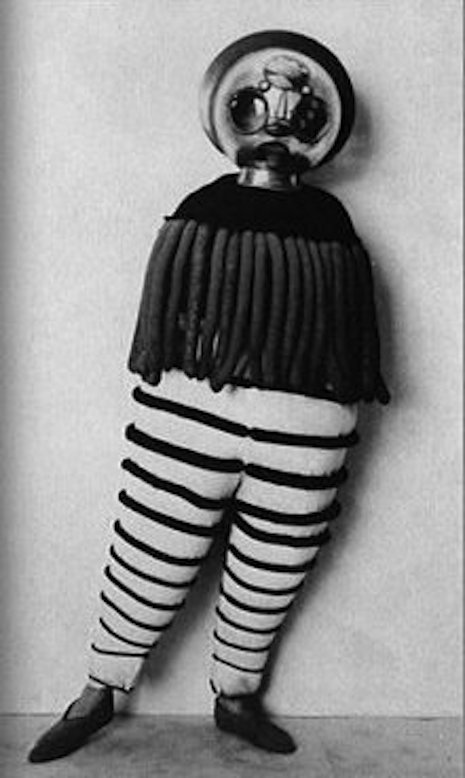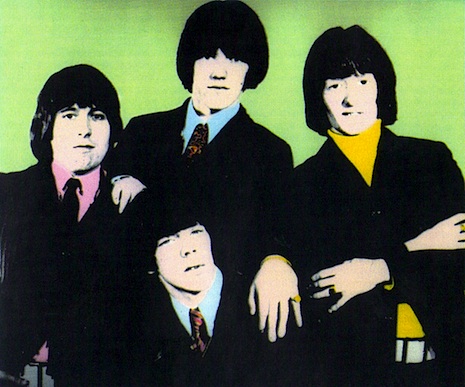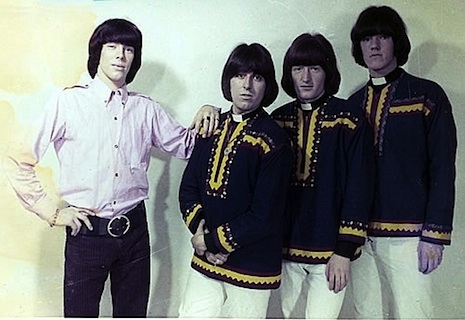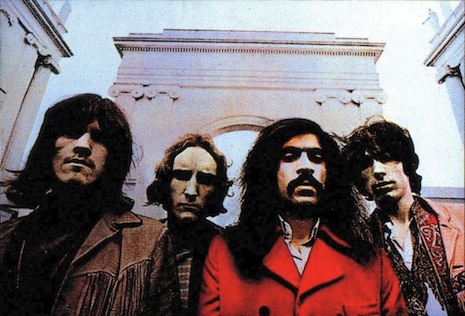
Graham Duff. Photo by Douglas Jones
Graham Duff is a prolific scriptwriter, producer and show runner. His latest TV show is the horror anthology series The Nightmare Worlds of HG Wells, starring Ray Winstone and Michael Gambon with a soundtrack courtesy of Damon Reece (Massive Attack) and Elizabeth Fraser (Cocteau Twins). He also created Ideal, the cult hit dark comedy that ran for seven series on BBC Three. As an actor he’s appeared in Doctor Who and Harry Potter and the Deathly Hallows.
Aside from all of that stuff, Graham Duff is a lifelong music fanatic and each year he contributes his “best of” list to Dangerous Minds.
30. Lonelady - Hinterland

 With her second album, Lonelady (aka Julie Campbell) has truly hit her stride. The post-punk touchstones are clear – the chopping rhythms of Gang of Four, the short, looping riffs of Wire and the truncated funk of early A Certain Ratio (especially in the bass propelled groove of ‘“Into The Cave” which boldly quotes from ACR’s “I Fall”). Yet Campbell is also capable of crafting lucid pop. On the title track, her melodic phrasing almost lulls you into believing you’re listening to a superior Cyndi Lauper. But it’s when she suddenly unleashes a guitar solo that comes on like a tripped out Robert Fripp you know you are in the hands of a true mistress of sound.
With her second album, Lonelady (aka Julie Campbell) has truly hit her stride. The post-punk touchstones are clear – the chopping rhythms of Gang of Four, the short, looping riffs of Wire and the truncated funk of early A Certain Ratio (especially in the bass propelled groove of ‘“Into The Cave” which boldly quotes from ACR’s “I Fall”). Yet Campbell is also capable of crafting lucid pop. On the title track, her melodic phrasing almost lulls you into believing you’re listening to a superior Cyndi Lauper. But it’s when she suddenly unleashes a guitar solo that comes on like a tripped out Robert Fripp you know you are in the hands of a true mistress of sound.
29. Helen - Original Faces

 At first listen, with its waves of fizzing, distorted guitar, rolling drums and partially submerged vocals, The Original Faces might appear to be a lo-fi shoegaze album. Although quite whether this is lo-fi or fau-lo-fi is hard to judge, as there are points when it feels like a clean studio sound which has been deliberately eroded. Not a solo artist, but a three piece band, Helen is the brainchild of Grouper’s Liz Harris. Yet frequently it’s Jed Bindeman’s fluid drumming which holds centre stage, with Harris’ guitar and Scott Simons’ plangent bass coalescing into a thick melodic cloud. Repeated exposure reveals that despite their noisy, rough corners, Helen’s songs have a genuine delicacy. This is an immersive and seductive collection of songs which worm their way under your skin.
At first listen, with its waves of fizzing, distorted guitar, rolling drums and partially submerged vocals, The Original Faces might appear to be a lo-fi shoegaze album. Although quite whether this is lo-fi or fau-lo-fi is hard to judge, as there are points when it feels like a clean studio sound which has been deliberately eroded. Not a solo artist, but a three piece band, Helen is the brainchild of Grouper’s Liz Harris. Yet frequently it’s Jed Bindeman’s fluid drumming which holds centre stage, with Harris’ guitar and Scott Simons’ plangent bass coalescing into a thick melodic cloud. Repeated exposure reveals that despite their noisy, rough corners, Helen’s songs have a genuine delicacy. This is an immersive and seductive collection of songs which worm their way under your skin.
28. Slug - Ripe

 Sunderland-based Ian Black joins forces with Field Music’s Brewis brothers for some decidedly skewed art-rock. “Cockeyed Rabbit Wrapped In Plastic” and “Eggs And Eyes” clearly owe a debt to the melodic excesses of early Sparks, whereas the moody angularity of album closer “At Least Show That You Care” recalls Henry Cow. Black is fond of adorning his ostentatious prog structures with elements of dub and funk, and it makes for an album of quirk, strangeness and charm. Some of the music’s undoubted ambition is occasionally dimmed due to a slightly offhand production. However, with a little more focus, Slug could develop into something extremely special indeed.
Sunderland-based Ian Black joins forces with Field Music’s Brewis brothers for some decidedly skewed art-rock. “Cockeyed Rabbit Wrapped In Plastic” and “Eggs And Eyes” clearly owe a debt to the melodic excesses of early Sparks, whereas the moody angularity of album closer “At Least Show That You Care” recalls Henry Cow. Black is fond of adorning his ostentatious prog structures with elements of dub and funk, and it makes for an album of quirk, strangeness and charm. Some of the music’s undoubted ambition is occasionally dimmed due to a slightly offhand production. However, with a little more focus, Slug could develop into something extremely special indeed.
27. AKATOMBO - Sometime Never

 The 4th long player from Akatombo (aka Paul Thomsen Kirk) is a dense and brooding nest of instrumental electronica. And if the mood is one of displacement and impending apocalypse, it’s not without reason. Over the last two years, Hiroshima-based Kirk has been suffering from a debilitating and life threatening illness. Indeed, field recordings of hospital visits and treatments are woven into tracks with titles such as “Scans and Needles.” In terms of its atmosphere of bass driven claustrophobic dread, the album’s closest cousin is probably PIL’s Metal Box. Although clearly a long way from being a feel-good album, what remains is a testament to one man’s ability to not only survive, but to translate his illness and fear of the unknown into a compelling sonic world.
The 4th long player from Akatombo (aka Paul Thomsen Kirk) is a dense and brooding nest of instrumental electronica. And if the mood is one of displacement and impending apocalypse, it’s not without reason. Over the last two years, Hiroshima-based Kirk has been suffering from a debilitating and life threatening illness. Indeed, field recordings of hospital visits and treatments are woven into tracks with titles such as “Scans and Needles.” In terms of its atmosphere of bass driven claustrophobic dread, the album’s closest cousin is probably PIL’s Metal Box. Although clearly a long way from being a feel-good album, what remains is a testament to one man’s ability to not only survive, but to translate his illness and fear of the unknown into a compelling sonic world.
26. Teho Teardo - Le Retour a La Raison

 The ever productive Teardo returns with a bold and intuitive collection composed to accompany several short abstract films made in the 1920s and 30s by the American surrealist Man Ray. Whereas many composers would have opted for a score which works comfortably as a background wash, Teardo’s compositions have a very clear identity and more than stand up to scrutiny without the visuals. The high points include “Hotel Istria” and “Rrose Sélavy” which showcase Teardo’s mastery of achingly beautiful sustained string arrangements. In contrast, Le Retour a la Raison spins into view on twitchy percussive loops before being swept away by maniacally circling violins, which eventually unclench to allow a mournful cello solo to blossom.
The ever productive Teardo returns with a bold and intuitive collection composed to accompany several short abstract films made in the 1920s and 30s by the American surrealist Man Ray. Whereas many composers would have opted for a score which works comfortably as a background wash, Teardo’s compositions have a very clear identity and more than stand up to scrutiny without the visuals. The high points include “Hotel Istria” and “Rrose Sélavy” which showcase Teardo’s mastery of achingly beautiful sustained string arrangements. In contrast, Le Retour a la Raison spins into view on twitchy percussive loops before being swept away by maniacally circling violins, which eventually unclench to allow a mournful cello solo to blossom.
25. Big Brave - Au De La by Southern Lord

 Montreal trio Big Brave are an intriguing band. Their drums, vocals, dual guitar, no bass line up is unusual, but certainly not unique (see Sleater-Kinney amongst others). Beyond that, one of the things which sets Big Brave apart, is their contrasting use of noise with space and silence. “On The By And By And Thereon” opens the album with chiming guitars and brief rests of quiet to dramatic effect. “Look At How The World Has Made A Change” sees Robin Wattie’s almost Bjork-like vocals floating over a gradually shifting landscape of humming guitars and ride cymbals, before building into the kind of alternately grinding and peaking dirge which recalls the early work of Sun O))). If you enjoy Merzbow or thisquietarmy, then Big Brave may well be to your taste.
Montreal trio Big Brave are an intriguing band. Their drums, vocals, dual guitar, no bass line up is unusual, but certainly not unique (see Sleater-Kinney amongst others). Beyond that, one of the things which sets Big Brave apart, is their contrasting use of noise with space and silence. “On The By And By And Thereon” opens the album with chiming guitars and brief rests of quiet to dramatic effect. “Look At How The World Has Made A Change” sees Robin Wattie’s almost Bjork-like vocals floating over a gradually shifting landscape of humming guitars and ride cymbals, before building into the kind of alternately grinding and peaking dirge which recalls the early work of Sun O))). If you enjoy Merzbow or thisquietarmy, then Big Brave may well be to your taste.
24. Gwenno - Y Dydd Olaf

 A Welsh language concept album apparently based on a 1970’s sci-fi novel. The idea might be interesting as a starting point, but it wouldn’t matter a jot if the songs didn’t cut it. And they do. Former member of The Pipettes: Gwenno Saunders seems to have found her true voice, trading in the kind of retro futurist pop which brings to mind Broadcast, or perhaps Saint Etienne at their most psychedelic. The majority of the tracks here roll along on dreamy synth lines underpinned by a featherlight motorik. Standouts include the wistful disco throb of “Golau Arall” which meshes soft detuned horn sounds with Saunders’ tumbling, breathy vocal.
A Welsh language concept album apparently based on a 1970’s sci-fi novel. The idea might be interesting as a starting point, but it wouldn’t matter a jot if the songs didn’t cut it. And they do. Former member of The Pipettes: Gwenno Saunders seems to have found her true voice, trading in the kind of retro futurist pop which brings to mind Broadcast, or perhaps Saint Etienne at their most psychedelic. The majority of the tracks here roll along on dreamy synth lines underpinned by a featherlight motorik. Standouts include the wistful disco throb of “Golau Arall” which meshes soft detuned horn sounds with Saunders’ tumbling, breathy vocal.
23. Sleater-Kinney - No Cities To Love

 Having disbanded a decade ago, following arguably their finest album The Woods, Sleater-Kinney return with a short, sharp jolt of an album. Ten songs. Over and out in 33 minutes with not a wasted note. Tracks like “Surface Envy” and “Hey Darling” prove that the band have lost none of their fire. It would be easy to read this as a set based around a more adult vision – to interpret the words as voicing the concerns of women who have matured. But in truth, this feels like Sleater-Kinney doing what they always excelled at, observing the world, finding it wanting and conveying that via choppy, angular guitar, propulsive detailed drumming and smart, biting lyrics.
Having disbanded a decade ago, following arguably their finest album The Woods, Sleater-Kinney return with a short, sharp jolt of an album. Ten songs. Over and out in 33 minutes with not a wasted note. Tracks like “Surface Envy” and “Hey Darling” prove that the band have lost none of their fire. It would be easy to read this as a set based around a more adult vision – to interpret the words as voicing the concerns of women who have matured. But in truth, this feels like Sleater-Kinney doing what they always excelled at, observing the world, finding it wanting and conveying that via choppy, angular guitar, propulsive detailed drumming and smart, biting lyrics.
22. Holly Herndon - Platform

 Bay area composer Herndon produces a form of glitch-tronica which is multilayered, richly detailed and in constant motion. The album features minimal instrumental sampling, with Herndon preferring to take sounds from non-musical sources, primarily noises generated by laptop and internet use. Although everything is subjected to such intense processing, it becomes impossible to pinpoint the samples’ origins. And yet it’s the way Herndon samples and manipulates her own voice which intrigues the most – especially on the more pop-tinged pieces such as “Chorus” or “An Exit.” On the album’s centrepiece, the uplifting “Morning Sun,” she fashions a song form which recalls both Laurel Halo and Laurie Anderson whilst retaining her own clear identity.
Bay area composer Herndon produces a form of glitch-tronica which is multilayered, richly detailed and in constant motion. The album features minimal instrumental sampling, with Herndon preferring to take sounds from non-musical sources, primarily noises generated by laptop and internet use. Although everything is subjected to such intense processing, it becomes impossible to pinpoint the samples’ origins. And yet it’s the way Herndon samples and manipulates her own voice which intrigues the most – especially on the more pop-tinged pieces such as “Chorus” or “An Exit.” On the album’s centrepiece, the uplifting “Morning Sun,” she fashions a song form which recalls both Laurel Halo and Laurie Anderson whilst retaining her own clear identity.
21. Bjork - Vulnicura

 Across her career, Bjork has covered many bases, from thoughtful yet obtuse electro ballads, to songs about living life on a molecular level, to pounding dance floor celebrations. Vulnicura, however is something different again. From the first note, it nails its colours to the mast as a break-up album. Lyrically, her descriptions of the act of separation veer from the deeply poetic to the near forensic, with loss of love depicted as a form of bereavement. The mix is in the hands of The Haxen Cloak (aka Bobby Krilic), but despite the fresh blood, the sparse and atmospheric string arrangements share a definite kinship with her masterwork Vespertine (2001), with “Stonemilker” especially, recalling the sweeping majesty of “Joga.”
Across her career, Bjork has covered many bases, from thoughtful yet obtuse electro ballads, to songs about living life on a molecular level, to pounding dance floor celebrations. Vulnicura, however is something different again. From the first note, it nails its colours to the mast as a break-up album. Lyrically, her descriptions of the act of separation veer from the deeply poetic to the near forensic, with loss of love depicted as a form of bereavement. The mix is in the hands of The Haxen Cloak (aka Bobby Krilic), but despite the fresh blood, the sparse and atmospheric string arrangements share a definite kinship with her masterwork Vespertine (2001), with “Stonemilker” especially, recalling the sweeping majesty of “Joga.”
20. Membranes - Dark Matter/Dark Energy 

 Over 25 years since the Membranes last album appeared, Dark Matter/Dark Energy shoots out of the traps with everything to prove. And goes on to pretty much prove it. John Robb’s original vision of a pummelling yet frequently joyful post punk/metal has aged extremely well. And the band aren’t afraid of going for the big themes; life and death, the birth and collapse of the universe and the fabric of reality. From the intense riffing of opener “The Universe Explodes Into A Billion Photons of White Light,” through to the ethereal drift of the closing moments of “The Hum of The Universe,” this is a powerful and epic album. Yet, thanks to the Membranes urgent bass driven repetition and jagged guitar work courtesy of Peter Byrchmore and Nick Brown, the band sidesteps bombast in favour of something much more vital.
Over 25 years since the Membranes last album appeared, Dark Matter/Dark Energy shoots out of the traps with everything to prove. And goes on to pretty much prove it. John Robb’s original vision of a pummelling yet frequently joyful post punk/metal has aged extremely well. And the band aren’t afraid of going for the big themes; life and death, the birth and collapse of the universe and the fabric of reality. From the intense riffing of opener “The Universe Explodes Into A Billion Photons of White Light,” through to the ethereal drift of the closing moments of “The Hum of The Universe,” this is a powerful and epic album. Yet, thanks to the Membranes urgent bass driven repetition and jagged guitar work courtesy of Peter Byrchmore and Nick Brown, the band sidesteps bombast in favour of something much more vital.
The top 20, after the jump…












































